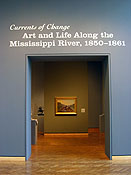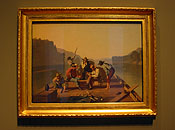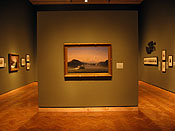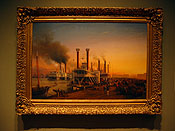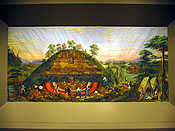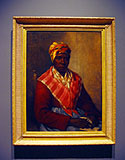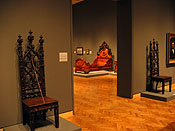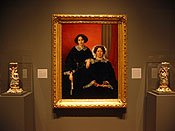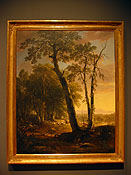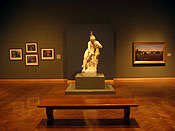The browser will either open the file, download it, or display a dialog.
|
||||||||
|
"Currents of Change: Art and Life Along the Mississippi River, 1850-1861" Jason T. Busch |
||||||||
| The artistic heritage of the Mississippi River valley has for some time moved in and out of the general public's recognition, remaining instead an area of scholarship specific to collectors, historians, and curators. The first major exhibition examining the arts of Mississippi River valley was held at the City Art Museum of St. Louis—now the Saint Louis Art Museum—in 1950, entitled "Mississippi Panorama." Following this exhibition, the Walker Art Center in Minneapolis organized an exhibition in 1976 entitled "The River: Images of the Mississippi." The most recent exhibition to treat the subject was during the early nineties when The Minneapolis Institute of Arts organized "Minnesota 1900: Art and Life on the Upper Mississippi, 1890-1915." Clearly research has been progressing in this area, but never has an all-encompassing view of the Mississippi valley been examined—one which suggests the diverse and dynamic nature of the entire River valley from the far reaches of the untouched north to the fashionable and bustling southern ports. Equally absent was an exploration of the overall importance of the River itself for the dissemination of ideas and the creation of a culturally refined Mississippi valley region. | ||||||||
| In a culmination of these diverse areas of research, the current exhibition at the Minneapolis Institute of Arts entitled "Currents of Change: Art and Life Along the Mississippi River, 1850-1861," curated by Jason T. Busch, Christopher Monkhouse, and Janet Whitmore, offers a fresh perspective of the River and the steamboat as the primary conduits for both the necessities of commerce and the propagation of artistic style (fig. 1). It introduces Midwesterners to a new sense of their artistic heritage and the importance that the river played in forging a new identity, one that was more than simply a product of aesthetic consumption, but also one of the dissemination of the image of the River itself . Itinerant artists, painters, sculptors, designers, and poets manifested a new identity for the River through their works, thereby introducing the Mississippi to the cultural milieu of America and advertising the beauty of the region far beyond its borders. | ||||||||
| Unique in its scale and scope, this large exhibition of over 150 objects, ranging from oil and watercolor painting to daguerreotypes to Rococo Revival furniture and porcelain, offers visitors a rare opportunity to explore more fully the artistic heritage engendered by the mighty Mississippi and to gauge the contribution of the River in the establishment of a sophisticated society. It commemorates the sesquicentennial of the "Grand Excursion," the steamboat tour which traveled along the Mississippi from Rock Island, Illinois to Saint Paul, Minnesota, taking visitors through the changing landscape and lifestyle that was the Mississippi valley. The exhibition is accompanied by a praise-worthy catalogue replete with images of the exhibition objects and more, including explanatory photographs. Three thematic essays provided by the curators offer a more in-depth analysis of the issues surrounding the exhibition. Considering the limited explanatory text provided along with the exhibition, those wanting to fully understand the arts of the Mississippi River Valley would be encouraged to secure the catalogue. | ||||||||
| Even before the eighteenth century, the Mississippi River valley had begun attracting explorers such as Marquette and Joliet who were drawn to the River Valley for its rich commercial prospects. These men and others established a strong French presence in the Mississippi River valley, a relationship that would continue to flourish, and which later impacted the arts of the nineteenth-century. With the continued expansion of commerce and trade along the Mississippi, the importance of the River shifted from being purely commercial to artistic—though its commercialism was never entirely separate. More artists and travelers began to seek out the river as a source of pleasure, inspired by its majestic qualities and tranquil landscape. As the interest in the river took on new dimensions, art and culture were invigorated by the influx of people and artistic ideas, establishing the River and its valley as a region with its own unique interests and aesthetic trends. | ||||||||
| Rather than examine the entire history of the Mississippi River valley, an almost impossible task, "Currents of Change" focuses on a definitive period in America's history—1850-1861. This was a period of industrial expansion and personal exploration just prior to the outbreak of the Civil War, when the steamboat was the primary means of transportation before the railroads obliterated their use. The steamboat offered both commercial transport and a luxurious tour along the river, where each person could marvel at the passing landscape. A key presence throughout the exhibition, the steamboat highlights the physical transmission of objects and underscores their suggested influence on acculturation. As the river valley continued both its industrial and residential development during this period, artists began grappling with the issue of how to portray these rapid transformations, an especially significant quality for the region of the upper Mississippi where the natural landscape was deeply prized. The exhibition also posits the question: Should the modernization of the Mississippi Valley, that which exploits the natural landscape and environment and distorts it into almost unrecognizable form, be heralded, or should the unaltered past be portrayed and glorified for its beauty and naturalness? | ||||||||
| Issues such as these surface upon examination of the organization of the exhibition, which is organized into seven rooms beginning with a geographic and then thematic arrangement accompanied by text explaining the very general context of the themes. Given the paucity of prior scholarship on this subject, however, viewers would have benefited from further wall contextualization or the presence of explanatory pamphlets. Despite this minor oversight, the depth and breadth of the objects presented is astounding, always maintaining a sense of rather refined luxury juxtaposed against the prevailing sense of the elegiac landscape setting. Arrangements of watercolors, daguerreotypes, photographs, and prints, complement the numerous pieces of porcelain, furniture, and oil paintings. The sheer diversity of materials presents a comprehensive view of the artistic predilections of communities and the patrons of the river valley. | ||||||||
| Mentioning this sense of refinement neglects the basic nature of the early rooms, which instead focus on the antithesis of this type of materialism—the natural and romanticized landscape. Before directly entering the exhibition, an elegant Rococo Revival style dinner service (1843; private collection) from the Jacob Petit Manufactory, Édouard Honoré Manufactory, and Louis-Marie François Rihouet, is placed to the right of the entrance and sets the stage for the sophistication of the art of the region. It also serves as a reminder that these styles were practical objects, part of the daily life of its residents who were attaining a level of culture and artistic complexity rivaling other parts of the United States. A sense of style and sophistication was visible from the earliest phases of the exhibition. | ||||||||
| After passing through the entrance, visitors are welcomed by the mythologizer of the Mississippi, George Caleb Bingham. His Raftsmen Playing Cards (1847; Saint Louis Art Museum, fig. 2) portrays the Mississippi as it once had been; young men floating along the mighty river in their rafts concentrate only on their game of cards, a seemingly simplified existence devoid of the pretense that accompanied the materialism of the later years. This lifestyle along the river had ended; by the 1860s, this setting had become history. The Bingham painting is surrounded by other key players of the Mississippi region of the previous and current era of the mid-nineteenth century. | ||||||||
| Bingham's composition clearly brings in an initial sense of nostalgia that is contrasted in the following room. Entering the next gallery, "The Father of Waters," the viewer is struck by Ferdinand Richardt's View of the Mississippi River (1857; Minnesota Historical Society, Saint Paul) which is positioned in a sharp contrast with the Bingham's image of the disappearing scene of the River. (fig. 3) The viewer is thrust into the present era of the steamboat, the glory of which is portrayed in an overall landscape that lacks the intimacy and approachability of Bingham's composition. There is little other suggestion of life beyond that of the great steamboat, symbolizing the fact that life on the River had begun to change, ushering in a new era that would eventually affect the artistic predilections of the entire Mississippi valley. Artists struggled with how to depict a landscape in a glorified form while dealing with the fact that this view was disappearing. It becomes clear, however, that artists were often interested in combining modern day machinery with idyllic riverscapes. Nevertheless, the juxtapositioning of these works underscores the constantly changing landscape of the Mississippi River valley during such a prolific period of transition. | ||||||||
| This aspect should not be overstated, however, as on a whole this theme seeks to introduce the upper Mississippi valley, and shows to what extent artists were inspired by the rugged but picturesque landscape and how this was manifested in their work. Paintings were complemented by historical maps and photographs from the period, providing a fixture of reality in broad comparison to that portrayed by the artistic ideal through paintings such as Bingham's and Richardt's. The diversity of objects represented continues to be a strong point throughout the exhibition, as it becomes a cultural study as much as an artistic examination. Also presented are the different aspects of the upper Mississippi valley including racial diversity shown by Seth Eastman's set of six watercolors framing his Ballplay of the Dakota on the St. Peter's River in Winter (1848; Amon Carter Museum, Forth Worth, Texas) which introduces the Native American Indian. An impressive large-scale composition, and one of the earliest known portraits of a domestic animal, Charles Deas' Lion (1841; Minnesota Historical Society, St. Paul), is a depiction of an Irish-Scottish wolfhound alert on the prairie, with Native Americans appearing in the distance which seems to be in the French "animalier" tradition of Charles-Émile Jacque and Constant Troyon. Perpetuated through these images is the notion, almost reminiscent of the mid-nineteenth century attitude towards the upper Mississippi, that there was indeed little in the north apart from an unsullied landscape. | ||||||||
|
By concentrating on shifts from the upper to the middle and lower Mississippi valleys, the romanticized version of the river landscape and its lack of industrialized pomp is pushed aside in the transition into another segment. Instead of the rough and rugged landscape of the north that inspired so many artists' praises, burgeoning communities based on the iron, ore, cotton, and sugar industries grew up along the river in the middle and lower regions. By nature of the cultural and geographic area described herein, works show the first strong presence of a French influence. Marie Adrien Persac's Norman's Chart of the Lower Mississippi (1858; Collection of Mr. and Mrs. L. J. Persac, Jr.), a large engraving and watercolor on paper, shows the nature of the changing river in the lower Mississippi region, with the land plotted out in arpents, a French-based land measurement unit. Residents were clearly taking advantage of the river access, and this shows how populated the river basin was. Large steamboats must have passed through many areas like this during their passage along the river. An immense painting by Hippolyte Sebron entitled Giant Steamboats at New Orleans (1853, Tulane University, New Orleans; fig. 4) is framed by two porcelain pieces evocative of the sophistication of the steamboat era, bringing in the dual aspect of the steamboat, for both commerce and pleasure. An overall comparison of this room with the previous gallery stressing the upper Mississippi shows the shifting importance of different areas of the valley, the north for its landscape and the middle and south for its commerce and luxury, further highlighting the perceived basic nature of the upper river valley. | |||||||
| The fourth segment of the exhibition is a culmination of the previous sections, and shows how the Mississippi was promoted through the traveling exhibitions of large-scale panoramas. In addition to an inward movement of styles and culture along the Mississippi River, there was an equally important outward dissemination of images of the river which attracted both artists and tourists to the area. The region became well known because of traveling panoramas and also because of the reproduction of paintings by firms such as Goupil & Cie, based in Paris but with a branch gallery in New York, who reproduced Bingham's Raftsmen and disseminated it to a Parisian audience. | ||||||||
|
On the periphery of the room are watercolors by Edwin Whitefield and Henry Lewis, both artists who traveled the Mississippi; Whitefield's work destined for a book of lithographs and Lewis' for a panorama. Their efforts frame the main feature of this area, which is an impressive seven-and-a-half foot high, 340-foot panorama by John J. Egan entitled Panorama of the Monumental Grandeur of the Mississippi Valley: Dr. Dickeson Excavating a Mound (c. 1850; Saint Louis Art Museum, fig. 5) that has never before been displayed since its initial showing during the 1800s. While only one part of this panorama is shown, a computer in the gallery allows viewers to see the entire panorama while scrolling on the computer screen. The curators have presented just one scene, but it is a relevant choice, showing exactly the broad panorama of peoples present in the River valley, complete with a racial hierarchy specific to the era. This racial hierarchy is subsequently challenged by a striking portrait by Jules Lion entitled, Asher Moses David and Son (Achille) (c. 1845, Collection of Ann and Jack Brittain and children) which shows a white man standing next to his biracial son. Common during this period were "free" black men and women, who had either earned or been born into their freedom. This is the first of several examples in the exhibition that show that blacks were seeking artistic representations just as their white counterparts had. | |||||||
| Continuing the racial panorama, entering into the fifth gallery, one immediately sees a dignified portrait of a black woman, entitled Delia (attributed to James Reid Lambdin (c. 1850; Collection of Sarah Lawrence and Bisland Oakes in honor of the Bisland and Lambdin families, fig. 6). In addition to linking the two rooms, the portrait shows the accumulation of these types of paintings as well as elaborate furniture and photographic portraits for mass consumption. This thematic room, "Handsomely Furnished," presents a broad view of interior decorative elements ranging from Saint Paul, Minnesota to New Orleans. This is the most domestic room of the exhibition, examining the consumption of style and the necessity of identification of personal artistic taste. This is the lifestyle of the wealthy; with grandiose canopied beds, the love of self-glorification through portraiture—all displayed in impressive mansions. Equally apparent is the interest in revival style furniture, evidenced by the gothic-revival (c. 1858; Stanton Hall, Pilgrimage Garden Club, Natchez, Mississippi) and Elizabethan revival style chairs (fig. 7). Clearly there were a number of artistic styles present along the river valley. | ||||||||
| The title of the sixth room, "In the French Taste," comes as a bit of a surprise, since the objects presented look strikingly similar to those in the rest of the exhibition. Much of the work in the previous galleries has already been "in the French taste," and again little textual analysis is provided for the visitor. Many of the objects represented here are by French artists, such as François Bernard, Charles Giroux, Hippolyte Sebron, and Marie Adrien Persac among others, and not Americans. Perhaps American artists working in this "French style" were too few and far between, their work too difficult to procure. In establishing a cultural identity, inclusion of solely French artists does little to advance the inbred artistic culture of the Mississippi valley. The relationship between the French and American artists is not explored in extensive depth and further; this section may have been improved by discussing the influx of French artists into New Orleans and up to Prairie du Rocher in Illinois. What the exhibition tantalizingly presents, the diffusion and creation of a French taste, is left unexplored in detail. | ||||||||
| Upon entering this gallery, a portrait, Mrs. James Belton Pickett, nee Paulina de Graffenried, and Sallie Pickett (Mrs. Robert Cummings) by Francois Bernard (1858; Historic New Orleans Collection) is framed by French rococo revival style candelabra bases attributed to Jacob Petit, showing the French interest in chinoiserie (c. 1845; New Orleans Museum of Art)(fig. 8). The portrait is highly reminiscent of the works of Jean-Dominique Ingres in its modeling of the figures' hands and heads and the overall positioning. Also included in this room is a section dedicated to artistic patronage, public exhibitions, and the establishment of art schools and museums along the Mississippi. Two landscape paintings by Asher B. Durand (1847; Mead Art Museum, Amherst College, Amherst, Massachusetts) link the two themes of French influence and artistic patronage together, bringing in a landscape suggested by French landscape imagery, but admitting qualities that were also taken on by an American artist and commissioned by American patrons (fig. 9). | ||||||||
| Concluding the exhibition is an entire section devoted to the poet Henry Wadsworth Longfellow, an especially important inclusion for the Minneapolis audience since his 1855 Song of the Hiawatha is based on Minnehaha Falls, located in what is now south Minneapolis. Longfellow had never been to the Mississippi valley, instead relying on secondary sources for poetic inspiration, such as the traveling panorama. The exhibition is based around Evangeline, published in 1847 and The Song of the Hiawatha, and features prints and paintings which were based on Longfellow's work. A significant work is the large-scale sculpture of Hiawatha by Augustus Saint-Gaudens (1874; Metropolitan Museum of Art, New York; fig. 10) which dominates the last gallery, demonstrating that this mythic Indian was a towering presence in American culture at the close of the century and a vital symbol for the region itself. | ||||||||
| Aside from a few questionable object placements, "Currents of Change" is an eye-opening exhibition that reveals the art from across the Mississippi valley, equally illustrating the life, customs and the artistic propensities of the region. The curators selected a diverse range of material that suggested the growing cultural sophistication of the river valley. Some themes emerge throughout the entirety of the exhibition, including the tension between artists who want to preserve the idyllic and untouched nature of the landscape and those who want to highlight the changing nature of the river valley in its push towards industrialization, almost foreshadowing the struggles of the mid-to-late nineteenth-century French artists active in Europe. It also becomes clear that artists were equally interested in conveying the positive changes that were being made. Bustling ports, sawmills of the upper Midwest, and especially the changes that took place at St. Anthony Falls were integrated into the natural environment with a sense of respect for progress and development. Simply because many artists tried to preserve the past through their palettes does not necessarily imply that other artists were resentful of the changes along the river; such an interpretation presupposes a contemporary understanding of the negative impact of historical development on the Mississippi Valley environment. | ||||||||
| A second aspect brought forth by the exhibition was that of diversification, speaking to racial and cultural diversity as well as commercial and topographical implications. Historically the Mississippi region, especially in the north, was a common meeting place where the French, American Indians, Americans, and Canadians would gather to trade goods. Throughout the region immigration brought in new people who brought their own styles, whether from Germany, Ireland, Scandinavia, or elsewhere. Further south, racial divisions and slavery practices were in question. Art began to further encompass these racial profiles and, referenced by this exhibition, saw both American Indians and African Americans seeking the same level of artistic patronage, such as in the portrait of Delia and the Jules Lion portrait of Ashur Moses Nathan and his son Achille, but also, daguerreotypes such as those executed by Thomas Easterly for Robert Wilkinson (c. 1860, Missouri Historical Society, St. Louis), Keokuk, (1847; Missouri Historical Society, St. Louis) and another, of an unidentified woman shown seated with coiffed hair and elegant clothing (c. 1850; Missouri Historical Society, St. Louis). Beyond racial diversification, the variety of the landscape was certainly present, and in this, an implied diversification in the arts as well. The commerce of the middle and lower river valleys engendered a certain style of elegant and refined luxuriousness, whereas the landscape of the north was heralded because of the advances of industry. There seems to be a clear shift from the upper to middle and lower Mississippi valleys; a shift towards a glamorous lifestyle evidenced by paintings of great estates, portraits, garden plans in the English picturesque tradition, public gathering spaces, and established real estate systems. Moreover, what this exhibition does exceedingly well is to reconstruct the visual nuances of these traditions against the various locations in the river valley. Still, throughout several of the rooms there seems to be insufficient distinction to fully grasp this potential diversity. | ||||||||
| The French element of the arts is also a consistent theme in the exhibition, but at the same time, too little information is provided for the viewer to fully contextualize this and to gauge its importance for both the inhabitants and the French artists who were working in this area. Scattered throughout the exhibition are French-design-inspired objects. Considering that the catalogue and the exhibition discuss the sense of establishing an identity for those communities of the Mississippi valley, it is interesting that the French influence was not more fully developed since it was key in the development and perpetuation of a stylistic image for the region. Granted, this show was not meant to be solely about the French influence in the Mississippi Valley, but many of the items chosen suggest such a heavy French influence, that it remains an important component throughout the region during the period the show covers. | ||||||||
| All of these aspects work together to forge a national identity for the Mississippi valley. Consistently overarching each of these themes is the importance of the steamboats moving along the River. This is less a theme than it is a goal of the show—to suggest that through transportation of objects from one city to another, traveling artists and shops aboard the luxurious cruisers, and by the simple possibility of moving objects along the river, the steamboat encouraged the transportation of wealth and style. In examining the presented works, viewers can gauge for themselves just what the identity of the mid-nineteenth century Mississippi valley was and how it was established and promoted. But it is a question of just how well the viewer, if they were to make their own assumptions, would differentiate between the rooms and the themes present therein. While they are geographically and thematically concise, many objects display such similarity that their differences are questionable. On the one hand this may suggest that along the river valley there was a similarity of styles, but the general organization of the show and selection of objects would not seem to have that as a primary goal. Outside of viewer interpretation, a key question remains: Where would the arts have been without the Mississippi and the steamboat as a method for their transmission? Once one answers this, one understands the overarching importance of the exhibition in illuminating the art and culture of a region seldom studied in such depth. While questions of interpretation remain, we owe the organizers a debt of gratitude for tackling such a complicated era and presenting the diverse themes with a sense of maturity and sensitive comprehension. | ||||||||
| Lynsi Spaulding University of Minnesota lynsis@umn.edu |
||||||||


